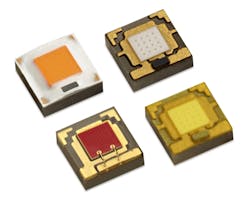Lumileds announces color and white packaged LEDs with improved punch (UPDATED)
The Luxeon CZ portfolio utilizes a minimal primary optic to increase the illuminance in the center of the beam and features monochromatic and phosphor-converted LEDs.
Lumileds has announced the Luxeon CZ Color Line of packaged LEDs designed for applications including entertainment, architectural-façade, and emergency-vehicle lighting. The solid-state lighting (SSL) components are a follow-on family to the Luxeon C products that feature a domed primary optic. The new CZ portfolio offers improved punch in the center of the beam and minimized crosstalk between adjacent components.
Interested in articles & announcements on packaged LEDs and design?
In total, the CZ family will include 13 color and eight white LED models, with a few of the color options and the white LEDs using phosphor conversion to deliver the specified spectrum. Other components are monochromatic color devices. Lumileds chooses the approach to color LEDs based on the efficiency that can be delivered and the unique colors that it has achieved through the use of phosphors.
At launch, amber, red-orange, red, royal-blue, blue, cyan, and green monochromatic LEDs will be available with deep-red, far-red, and violet due by mid-year. Phosphor-converted mint and amber LEDs will be available immediately with lime also arriving by mid-year. And the phosphor-converted white offering will span 3000K to 5700K CCT at launch, growing to 2700K to 6500K by mid-year.
Bold colors and bright whites are emitted by the latest packaged LEDs offered by Lumileds in the Luxeon CZ family.
Lumileds rolled out the Luxeon C line similarly in 2015. The advantages of that offering were total lumen output and a fixed focal length (component height) that delivers better uniformity in color-mixing applications such as façade lighting.
The CZ series is based on the same basic architecture but has an almost-flat top surface and minimal primary optic that consists of a thin silicone layer. The LEDs still have the same focal length across the portfolio for uniformity. But the new design delivers the aforementioned added punch.
Lumileds defined the punch using a cd/lm metric. Basically, the specification defines the amount of energy focused in the center of the beam. The CZ LEDs fall in the range of 73 to 79 cd/klm (kilolumen). The company said color LEDs from competitors top out at around 60 cd/klm and that some are even much lower.
Indeed, Jennifer Holland, product line director of the Luxeon Color Family, said, “The Luxeon CZ features up to 48% more punch than any other undomed color LED.” And she said a domed LED essentially magnifies the size of the source, possibly delivering more overall lumens. But secondary optics for products such as façade fixtures can work more efficiently and focus the beam with the smaller effective source size that comes courtesy of the flat approach.
The final advantage of the new packaged LEDs comes in the ability of product developers to closely pack the devices in arrays — a technique needed for good color mixing. Low thermal resistance of 3.2°C/W in part makes the tight packing possible. But also the fact that the package design limits crosstalk is a key. Holland showed a photo of a blue LED with four other LEDs mounted directly adjacent to it on each side. You could readily see light from the blue emitter activating the phosphor in the surrounding LEDs. In a case based on a CZ LED in the middle, however, there was very minimal crosstalk evident.
Color LEDs can be quite a different challenge for product developers relative to white LEDs. For background on the technology, see the feature article we published on the topic a few years back.
*Updated Mar. 14, 2018 4:23pm for units correction.

Maury Wright | Editor in Chief
Maury Wright is an electronics engineer turned technology journalist, who has focused specifically on the LED & Lighting industry for the past decade. Wright first wrote for LEDs Magazine as a contractor in 2010, and took over as Editor-in-Chief in 2012. He has broad experience in technology areas ranging from microprocessors to digital media to wireless networks that he gained over 30 years in the trade press. Wright has experience running global editorial operations, such as during his tenure as worldwide editorial director of EDN Magazine, and has been instrumental in launching publication websites going back to the earliest days of the Internet. Wright has won numerous industry awards, including multiple ASBPE national awards for B2B journalism excellence, and has received finalist recognition for LEDs Magazine in the FOLIO Eddie Awards. He received a BS in electrical engineering from Auburn University.





